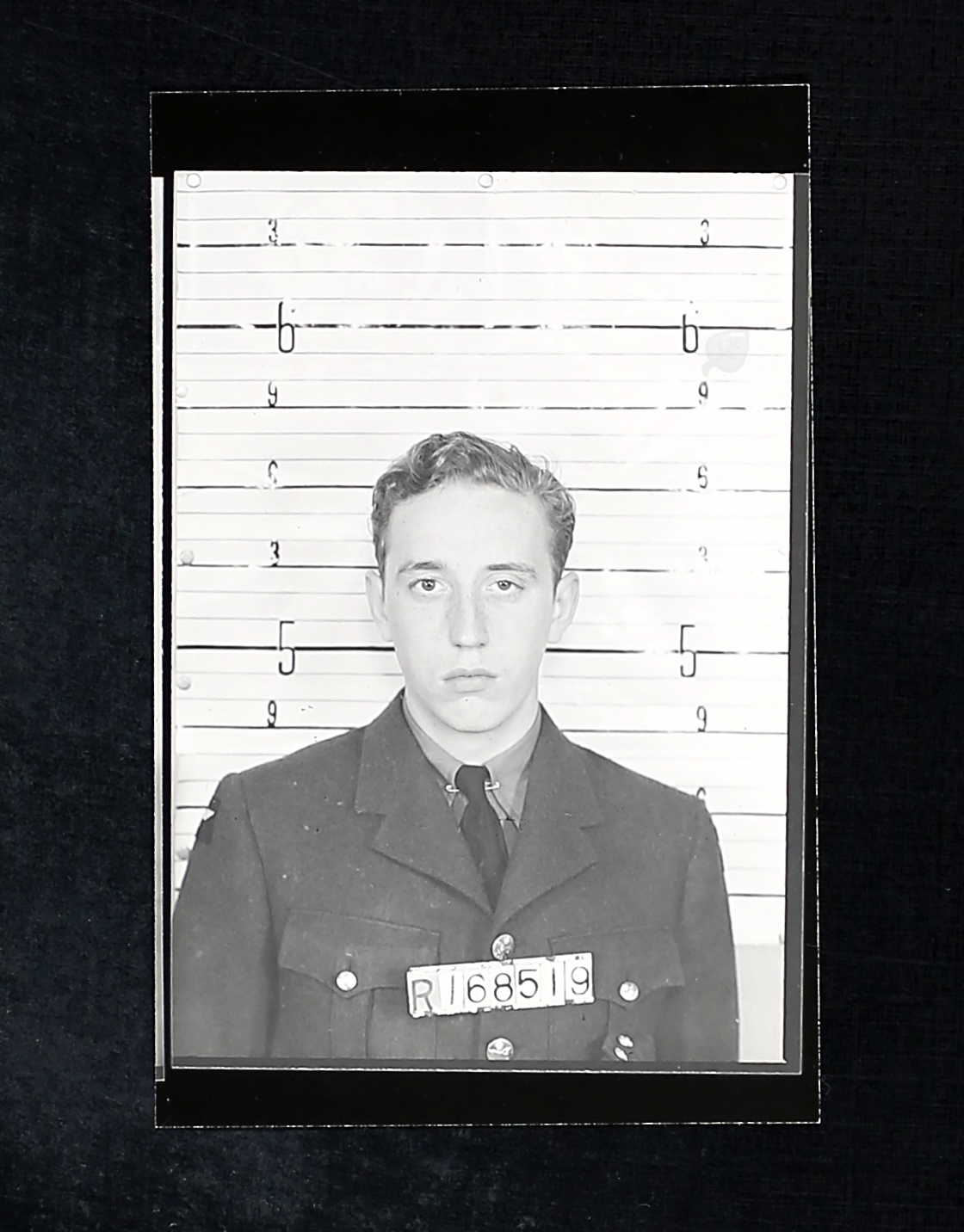
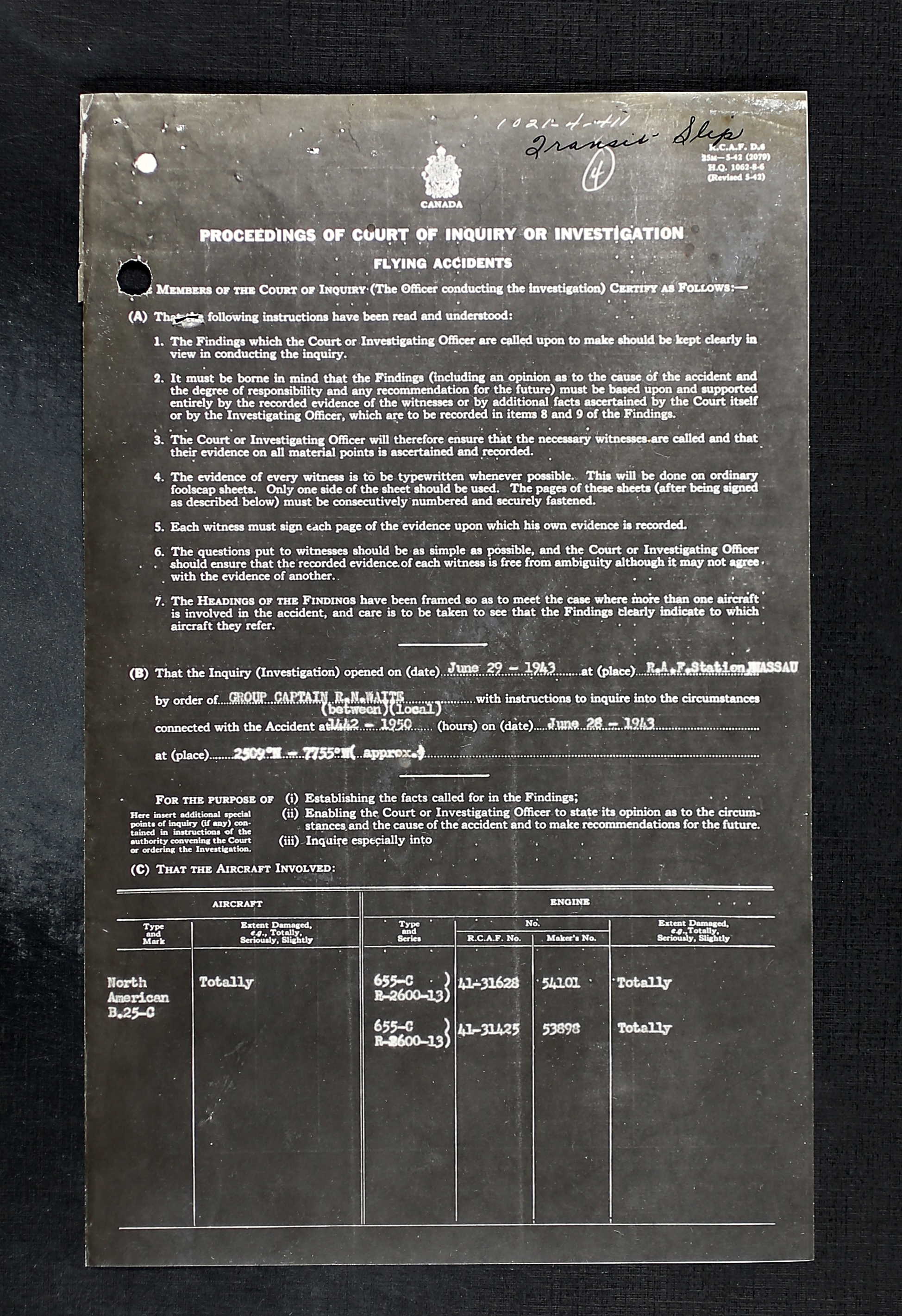
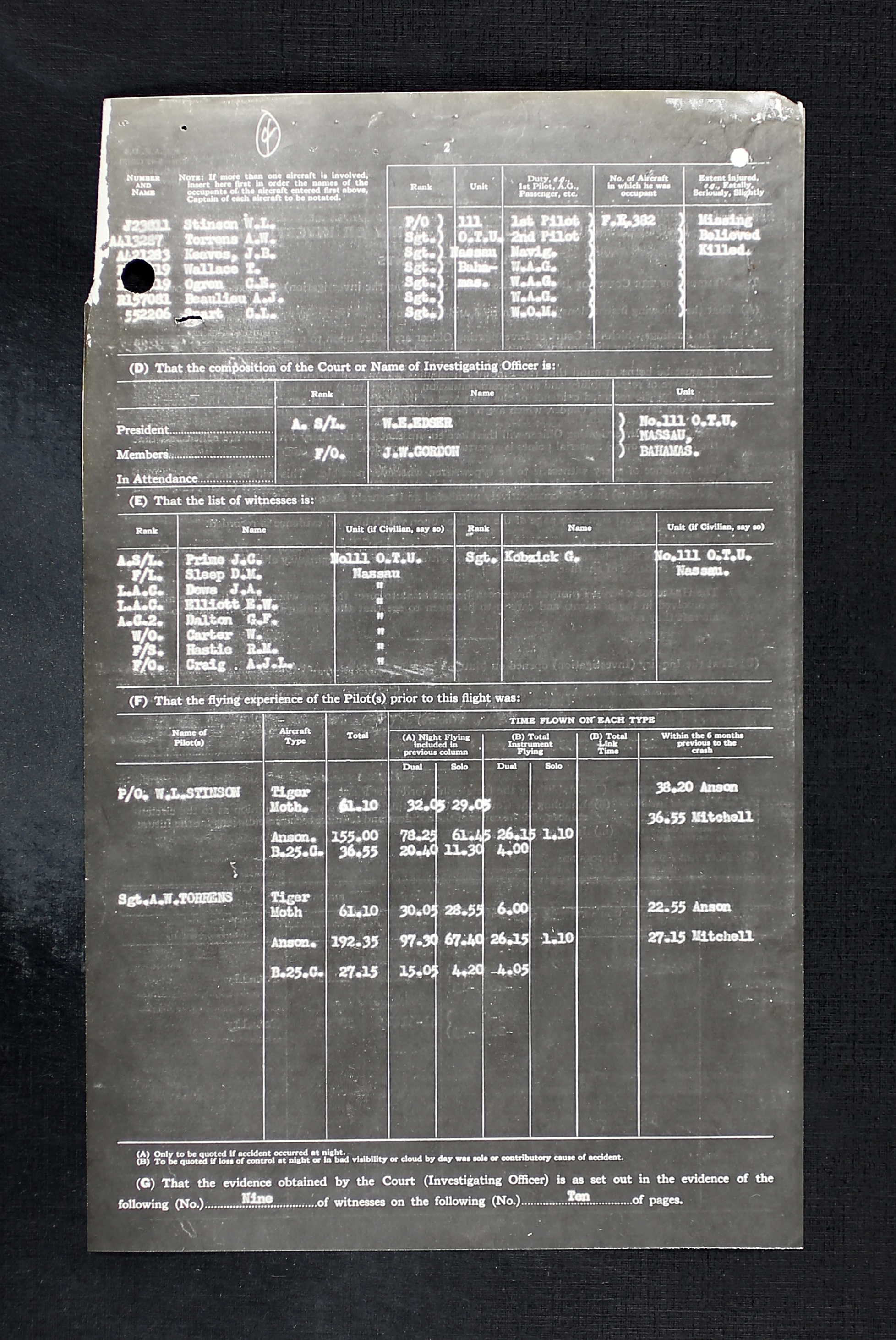
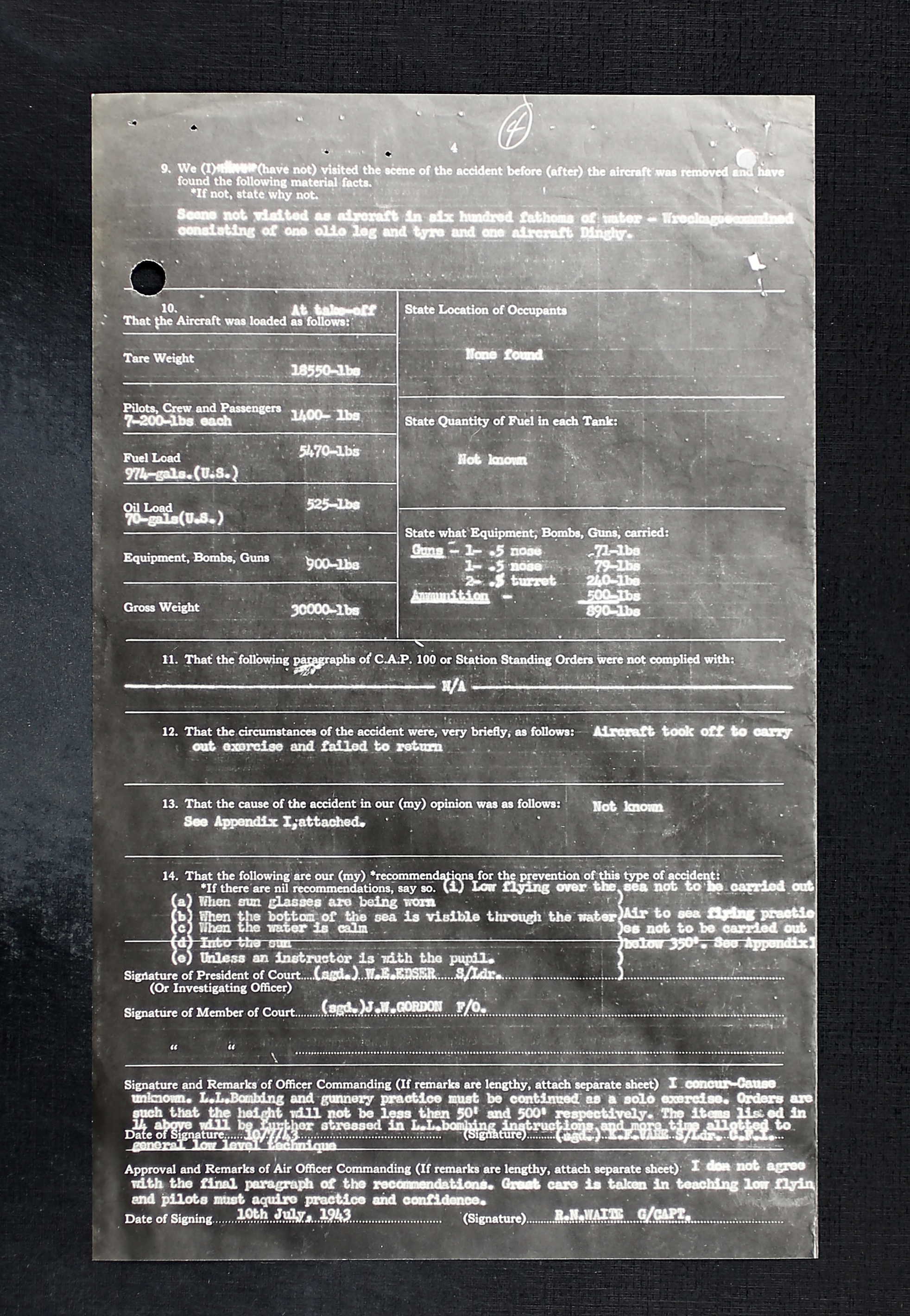
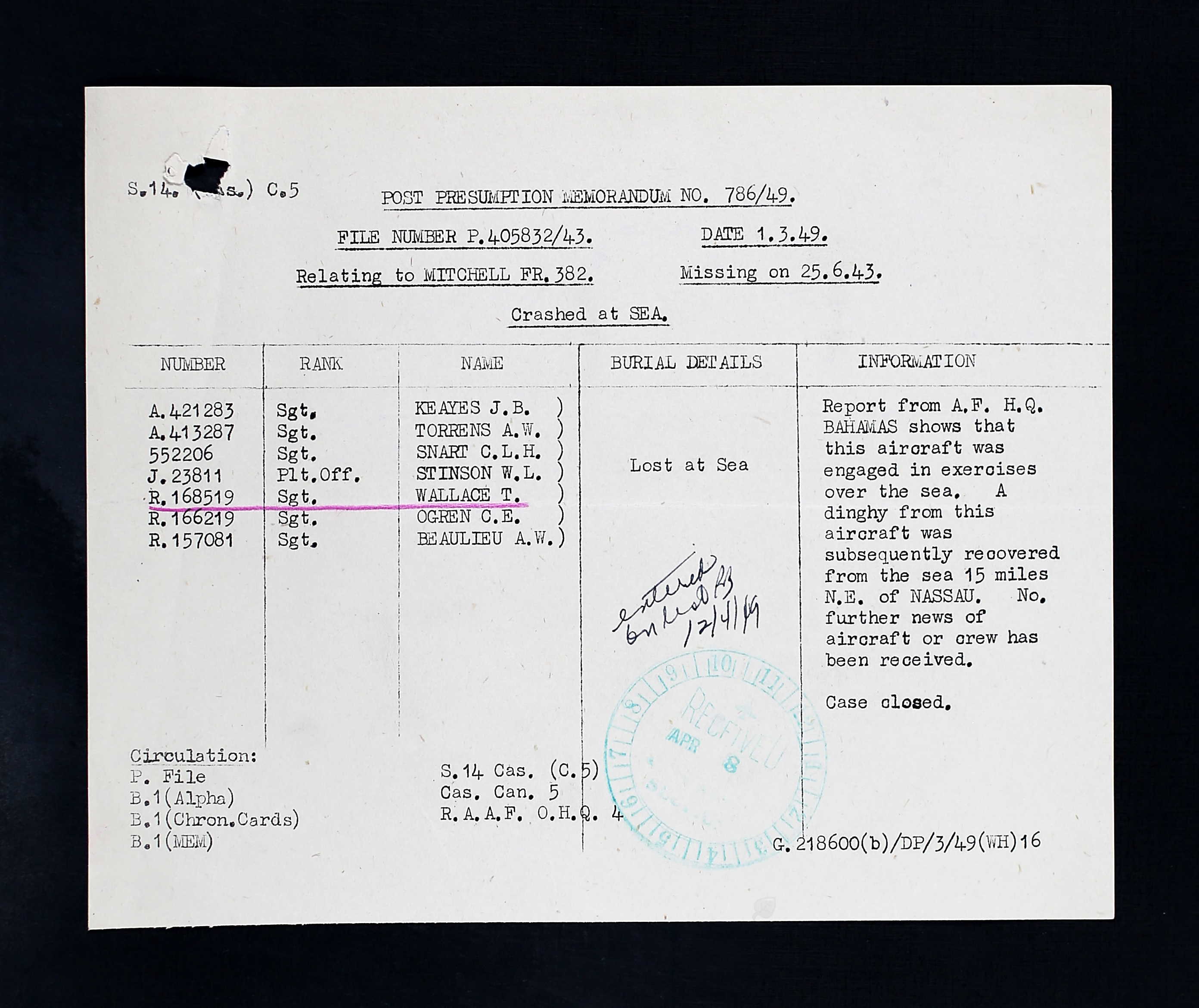
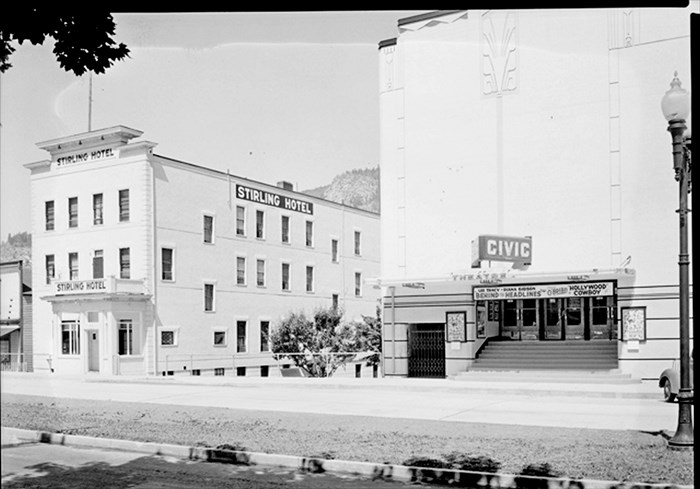

May 1, 1924 - June 28, 1943







Thomas Wallace, born in Vancouver, BC, was the son of Hugh Williams Wallace (1885-1932), theatre manager, and Agnes (nee Fitzsimmons) George (1900-1983) of Nelson, then Vancouver, British Columbia. He had one brother, Hugh Fitzsimmons Wallace (K1943), who joined the Canadian Army. Thomas’s step-father, Laurence George (K63147) was a corporal in the Army. The family attended the United Church.
He had a Grade IX education, with a partial Grade X. Thomas was a salesclerk in a drug store and theatre usher at the Civic Theatre in Nelson, who liked boating, swimming and playing badminton. He smoked ten cigarettes a day and drank the occasional beer. Thomas bought seven x $5.00 War Savings Certificates. He wanted to return working in the theatre business when the war was over as a showman.
Thomas spent seven months in the Canadian Army (K37709) before enlisting with the RCAF in May 1942, lying about his age, claiming he was born in 1921. He had a linear scar 1” left hand dorsus between thumb and index finger. He had brown eyes and dark blond hair. “Wiry physique and standard mentality.” He stood 5’7 ½” tall and weighed 152 pounds. “Nail bitten. Denies nervousness. Does not seem a highly strung type.” Other comments: “Ocular balance poor. Physically fit. Keen to be a gunner. Should do better than average.” On his Interview Report: “A little low on score but very keen. Discharged from army twice -- underage. Knows Brens and Lewis guns. Very anxious to get in as a gunner. Likes guns and has had army training on both Brens and Lewis guns. Think he will make a first class WOAG. All kinds of spirit.”
He started his journey through the BCATP at No. 3 Manning Depot, Edmonton, Alberta on May 27, 1942 until he was sent to No. 2 Wireless School in Calgary July 18, 1942. Thomas was at No. 5 B&G School, Dafoe, Saskatchewan March 6 until May 2, 1943. He was then sent to No. 5 Manning Depot, Lachine, Quebec and posted to No. 111 O.T.U. Nassau, Bahamas May 11, 1943.
Aboard Mitchell FR 382, seven aircrew lost their lives while engaged in low level attack exercises over the sea on June 28, 1943. The last communication was at 1915 hours. At 2253, Signals supervisor stated no mention off anything abnormal at change of watch at 2100. At 2350, a dinghy was sighted and later recovered on June 29th at 1120 from the sea 15 miles NE of Nassau, Bahamas. No further news of the aircraft of crew was received. Searches were made to search north and east beaches twenty miles for possibly parachutes. A wheel and spar were also recovered. Those aboard were Sgt. James Bryan Keayes, A421283 (RAAF), son of James Lawrence Keayes and Cecelia Keayes, Nambucca Heads, NSW, Australia, Sgt. Arthur William Torrens, A413287 (RAAF), son of Thomas B. Torrens and Esther Georgina Torrens, Ballina, NSW, Australia, Sgt. Charles Leslie Herbert Snart, 552206 (RAF), Pilot Officer William Lorne Stinson, J23911 (RCAF), son of John C. Stinson and Aldyth Lavina Stinson of New Westminster, BC, Sgt. Thomas Wallace, R168519 (RCAF), son of Hugh W. Wallace and Agnes Wallace of Vancouver, BC, Sgt. Carl Eric Ogren, R166219 (RCAF), son of Harold Gustav and Elizabeth Ogren of Winnipeg, Manitoba, and Sgt. Arthur Joseph Beaulieu, R157081 of Vancouver, BC.
A Court of Inquiry was struck with eight witnesses. Visibility more than 15 miles. Weather fair with possible scattered showers. “Occupants were not instructing each other.”
The first witness, S/L John Charles Prime stated that he was the OC ‘B’ Squadron No. 111 C O.T.U. Nassau, Bahamas. “I ordered an operational exercise flight to be carried out by P/O Stinson and crew, an aircraft DD (FR382) type 25C Mitchell on June 28, 1943. The time of the take-off ordered was 1445 hours for three hours’ duration. Operational air exercise No. 3 was detailed. F/L D. M. Sleep authorized this flight as my deputy in my absence. On the morning of 28th June 1943, P/O Stinson and his crew, had received dual instructions in general flying and bombing, in aircraft 382, in readiness for the solo exercise. Aircraft FR382 took off at 1442 hours on 28th June 1943 and W/T communication between the aircraft and the ground was established, the last signal received by the ground station was at 1515 hours and after that time no further communications could be established. Five search aircraft were despatched on the receipt of the information that the aircraft FR382 was overdue and at 1950 hours, an aircraft dinghy was sighted in the sea, off Morgan’s Bluff, Andros island. No sign of life was apparent and no wreckage was visible. The light at this time would not enable the searching aircraft to see very well. On 29th June 1943, at dawn, marine craft and one aircraft were searching in the vicinity in which dinghy had been sighted 28th June 1943 and the dinghy which bore the aircraft letters FR382 and the main landing wheel, oleo leg from a Mitchell aircraft were recovered from the sea. Search by aircraft and surface craft was continued by without further result. Second pilots are not to fly below 1000 feet unless an instructor is present or when air-firing practice is being carried out by the Captain.”
The seventh witness, F/S Robert Miller Hastie, 1107486, stated, “I am a flying instructor in B Squadron, No. 111 C O.T.U. Nassau, Bahamas. I gave instruction in 50’ A.S. Bombing to P/O Stinson and to Sgt. Torrens during the forenoon June 29, 1943. We flew Mitchell FR382. P/O Stinson’s low level bombing was average, Sgt. Torren’s low level bombing was average for second pilot. He was below standard for a first pilot, though this was my first flight with him, that was the impression I gained during the twenty minutes he was flying.”
The eighth witness, F/O Alan John Laird Craig, flying instructor stated that “I was Sgt. Torren’s instructor during his conversion on to Mitchell aircraft. Sgt. Torren’s flying, in my estimation, was below the average on Mitchells. I have had approximately 500 hours of instruction.”
“OBSERVATIONS OF THE COURT: (1) The cause of the accident is unknown. (2) The presence of the starboard oleo leg would suggest that the aircraft hit the sea with considerable force and that a ditching was not being made. (3) The cause of the accident might equally be, structural failure, engine failure, error of judgement, a mishandling of the aircraft by the pilot flying at the time. (4) Instructions issued in ‘B’ Squadron are such that the second pilot should not have been flying, however, this cannot be determined, but may have happened. (5) In view of the evidence given regarding the serviceability of the aircraft, particularly that of F/S Hastie, and considering the fact that low flying was necessary for the completion of the exercise, the possibility of a pilot’s error of judgement, or mishandling of the aircraft becomes quite apparent.
RECOMMENDATIONS OF THE COURT: The Court wishes to make it quite clear that it does not attempt to prove low flying over the sea, as it is the cause of the accident; however, it is one form of flying that even with experienced pilots can be quite hazardous; particularly when a pilot is not in practice. This danger becomes more acute when conditions such as occur in this area, are present. These conditions are: (1) Extreme conditions of glare, requiring the use of sun-glasses by most people part of the time (2) Considerable period of calm (3) Large areas where the bottom of the sea is visible through the water. In view of these remarks, it is the opinion of the Court that, during the pupil’s O.T.U. training, all his low flying should be in the form of instruction and none should be done solo.”
Other recommendations: Low flying over the sea not to be carried out when sunglasses are being worn, when the bottom of the sea is visible through the water, when the water is calm, into the sun, unless an instructor is with the pupil. Air to see firing practice is not to be carried out below 350’. S/L Vare stated that “Low level bombing and gunnery practice must be continued as a solo exercise. Orders are such that the height will not be less than 50’ and 500’ respectively.” G/C Waite stated, “I do not agree with the final paragraph of the recommendations. Great care is taken in teaching low flying and pilots must acquire practice and confidence.” July 10, 1943.
The scene of the accident was not visited “as aircraft in six hundred fathoms of water.”
In late October 1955, Mrs. George, Thomas’s mother, received a letter informing her that since Thomas had no known grave, his name would appear on the Ottawa Memorial. Thomas's name is also on the Nelson Cenotaph.